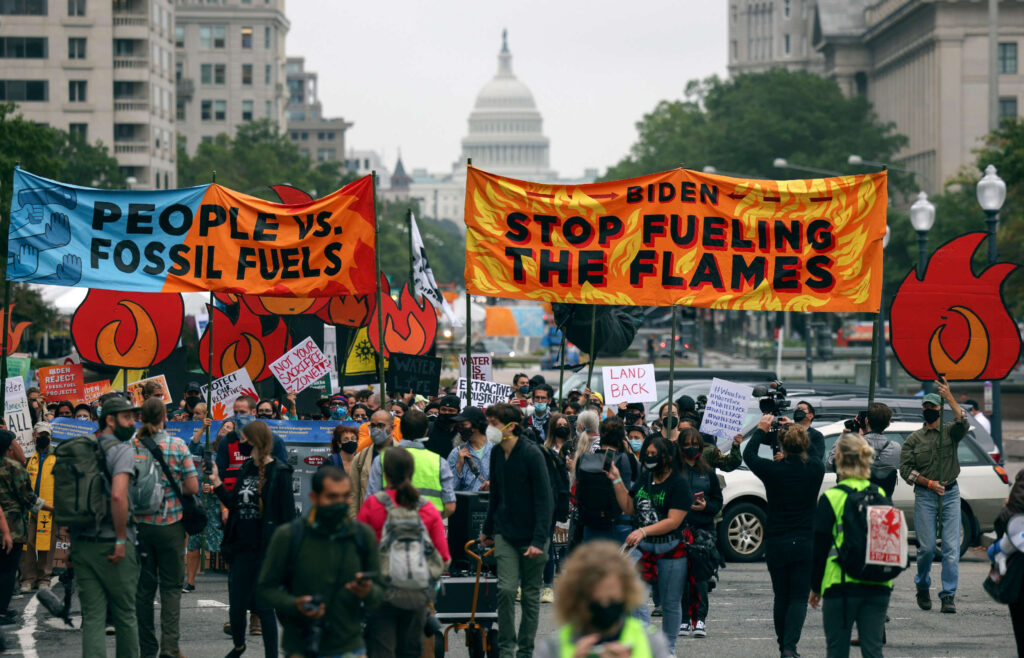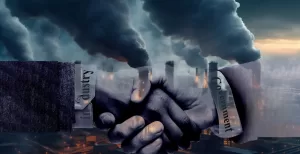In 2021, our atmospheric ills continued to crystalize. Two massive, converging weather events formed a hulking heat dome above the Pacific Northwest: blasting through heat records and killing hundreds of people, who perished due to hyperthermia and other heat-related illness. Globally, more than 4,000 migrants died while moving over land or sea, many of them fleeing unlivable climatic conditions.
Researchers uncovered stronger evidence that the global ocean conveyor belt — the one that keeps hot and cool air flowing to corners of the Earth at levels that sustain life — has slowed to a rate of circulation more sluggish than any time in the last 1,000 years. As Bill McKibben wrote for the New Yorker: “We’re breaking really big things.”
But we’re also building “really big things” — namely, movements — activists and scholars point out, as climate scientists stress that there’s still time to mobilize to avoid the most devastating impacts of the climate crisis. And so, this year’s climate “wins,” organizers say, are essential to take stock of.
“I personally celebrate every single victory, small or large,” Joye Braun, a member of the Cheyenne River Sioux Tribe and national pipelines organizer for Indigenous Environmental Network, told Truthout. To be an organizer, she says, is exhausting. It means being vilified by the media for standing up for clean water and clean air, facing death threats from multinational corporations, and keeping hope alive as long-overdue federal climate legislation is blocked by a system in which a single fossil-fuel backed lawmaker, Sen. Joe Manchin (D-West Virginia), has the power to knock it on its heels.
“You need [to celebrate] in order to keep going, to know that you can fight against these extractive industries and win,” Braun said. And the wins add up. A study by Stanford sociologist John Muñoz found that greenhouse gas emissions decline in states where there are higher levels of “pro-environmental protest.”
As such, Truthout asked organizers and scholars about the triumphs and trends they’re most heartened by this year. Here’s what they said.
We Know Who’s at Fault
For the first time ever, Big Oil executives were called on to publicly answer questions under oath about how they knowingly deceived the public about gas and oil’s outsized contribution to the climate crisis. Unsurprisingly, during the six-hour hearing, many dodged the toughest questions — such as whether their companies would commit to stop lobbying against laws designed to reduce greenhouse gas emissions. But shaming, and naming, was had. The companies were subpoenaed, and are now required to disclose how much they are spending to fund campaigns to fight climate policy.
“We need to get to the bottom of the oil industry’s disinformation campaign, and with these subpoenas, we will,” said Rep. Carolyn Maloney (D-New York), who led the hearing.
The six-hour event wasn’t Big Oil’s first reckoning, but it did help put more faces to names for a public increasingly familiar with the forces driving the climate crisis, which the oil and gas industry has fought hard to blunt. According to a United Nations poll conducted earlier this year, the majority of people across the world believe climate change is a global emergency.
And 60 percent of people in the U.S. now say oil and gas companies are at fault and should be held accountable, according to a poll commissioned by The Guardian, Vice News and Covering Climate Now. Clearer culpability shapes a stronger rallying cry for climate campaigning. “Abolish these oil companies, finish them, get rid of them, no more,” Ayisha Siddiqa, co-founder of youth activist group Polluters Out, told The Guardian earlier this year. Scholars suggest such sentiment could engender broader support for a fossil fuel phaseout, including potential “managed decline” — the shifting of fossil fuel entities to public ownership, enabling the government to protect workers from widespread layoffs and prevent executives from continuing to benefit from extraction and bailouts.
One-Third of Major North American Pipeline Projects Were Canceled
In May, activist groups that played a key role in the Keystone XL cancellation launched the Pipeline Fighters Hub — a “one-stop shop” where members of the public, the media and decision makers could access information about pipeline proposals, protests and how to support those on the front lines.
“When farmers, ranchers, Tribal Nations, and climate activists took on Keystone XL over a decade ago, Big Oil had a playbook to bully us,” said Jane Kleeb, the founder of activist group Bold Nebraska, in a press release. “We formed an unlikely alliance and learned how to fight back.”
In the months to follow, three more fossil fuel projects, of 12 total that the hub has formally mobilized against, subsequently bit the dust. In July, Plains All American canceled the Byhalia Connection, which would have cut through a string of historically Black neighborhoods in Memphis, Tennessee; in September, PennEast announced it would no longer build a 115-mile natural gas pipeline sending fracked gas from the Marcellus Shale to New Jersey; and in December, Pembina nixed the Jordan Cove LNG export terminal project and its associated Pacific Connector Gas Pipeline, which would have crossed 485 rivers and streams and impacted Klamath territories.
“A lot of those victories have come about because there have been greater alliances built,” said Braun, who is closely involved with the Pipeline Fighters Hub, noting that activists are increasingly savvy about fossil fuel developers’ manipulative and racist tactics.
Justin J. Pearson, co-founder of Memphis Community Against the Pipeline, the coalition that resisted the Byhalia Connection, credited the growing national network for the Bluff City’s win. “Many folks across the country sent emails, made phone calls, signed the petition or invited us to speak about this issue and elevated it to a national level,” Pearson told Truthout shortly after the pipeline was canceled in July. “We are a part of a history of pipeline fighters, some who have lost, and yet sparked that resistance.”
Indigenous Leaders Are in Powerful Positions
In Canada, Chile and the United States, Indigenous leaders took on top government appointments. This summer, Inuk leader Mary Simon was named the first Indigenous person to serve as Canada’s governor general; and Mapuche scholar and activist Elisa Loncón was appointed president of Chile’s Constitutional Convention.
Stateside, in November, Charles F. Sams III, a member of the Confederated Tribes of the Umatilla Indian Reservation, became the first Indigenous person appointed to lead the National Park Service, following Deb Haaland’s historic appointment to head the Department of the Interior in March. Haaland is an enrolled member of the Laguna Pueblo.
“Her nomination for secretary of the interior largely came about because Indigenous activists had a wild idea, tested it, and lobbied President Joe Biden to follow along,” Jenni Monet, herself a member of the Pueblo nation, wrote in Sierra Magazine.
Representation is not everything. Much, if not most, resistance occurs from outside of the existing political system. But species are going extinct faster than in any other period of human history and it’s clear who’s best at maintaining healthy ecosystems. Although Indigenous peoples make up only 5 percent of the population and live on 25 percent of Earth’s surface, their lands contain as much as 80 percent of existing biodiversity.
Appointing Indigenous leaders may carry a greater potential to implement policies that deliver environmental and social protection, such as restoring tribal homelands, when compared to electing or appointing settler-colonial counterparts, though Braun has pointed out that Haaland’s hands have thus-far been largely “tied by the Biden administration’s policies.”
As Haaland herself explained in June at the National Congress of American Indians mid-year conference, Indigenous appointments also begin to address a legacy of immeasurable injustice. “This moment is profound when we consider that a former secretary of the interior once proclaimed his goal was to, quote, civilize or exterminate us…. I am a living testament to the failure of that horrific ideology.”
Cities and States Made Major Milestones
Just this month, the state of Nebraska became the first red state in the nation to make plans to fully decarbonize its grid, and New York City became the largest municipality in the U.S. to ban new natural gas hookups in buildings.
The ban on natural gas hookups in New York City effectively phases out the use of gas for cooking and heating in new buildings, following similar maneuvers by over 40 other U.S. cities. Gas-burning stoves appear to worsen the risk of childhood asthma due to nitrogen dioxide and particulate matter released from combustion, and natural gas infrastructure, including hookups, are a leading cause of urban methane leakage. Overall, buildings and construction account for some 40 percent of all energy-related greenhouse gas emissions.
Ben Furnas, the city’s sustainability chief, told E&E news that if the shift can be made in the Big Apple, it can happen anywhere. “We’re big, we’re dense, we’re complicated, we have all four seasons. We’re putting a marker down, saying the next generation of buildings is going to be electric. We want to be a model for the world,” he said.
Nebraska’s 100 percent clean energy commitment was particularly sweet after Manchin rejected a major push to include a clean electricity program in federal climate legislation.
Nick Abraham, state communications director for the League of Conservation Voters, attributed the win to six years of organizing. “Such an incredible story of dedication,” Abraham wrote on Twitter. “You can win on clean energy in rural communities.”
Kamal Kapadia, researcher and co-founder of the online climate school Terra.do, says the blueprint Nebraska offers is invaluable. “I have more hope and faith in local action, honestly. These things can have cascading effects.”
A Seismic Shift?
Between COP26, which was a flop, the dwindling of Build Back Better, and the largest-ever sale of oil and gas leases in the Gulf of Mexico, 2021 has also been laden with losses and setbacks.
But in spite of it all, change from below is reaching the highest ranks, according to Kapadia. Even just five years ago, it appeared that countries’ combined climate pledges were dooming us into projected warming of 4 or 5 degrees Celsius (4 or 5°C). Now, we’re in the range of 2 to 3.6°C. Many of these pledges are insufficient. Small island nations are calling for “1.5° to stay alive,” which world leaders are failing to act on. Still, the lower warming target is a seismic shift from where things were a few years ago, Kapadia said.
“If you look back in time, there is no one big movement that caused this to happen. This is literally the result of hundreds, thousands of movements and ‘small victories,’” she said.
Braun said some of the movement growth she’s witnessed is coming from unexpected places, which she anticipates more of in 2022. “I see courage and people who wouldn’t have fought [years ago] starting to stand up,” Braun said. “I see alliances made with ranchers and farmers and Native Americans and hippies and New Age people, and it doesn’t mean that we all agree. It just means that we’re standing up for what is really important.”
(Leanna First-Arai is a freelance journalist who covers environmental and climate (in)justice. Courtesy: Truthout. Truthout is a nonprofit news organization dedicated to providing independent reporting and commentary on a diverse range of social justice issues.)




